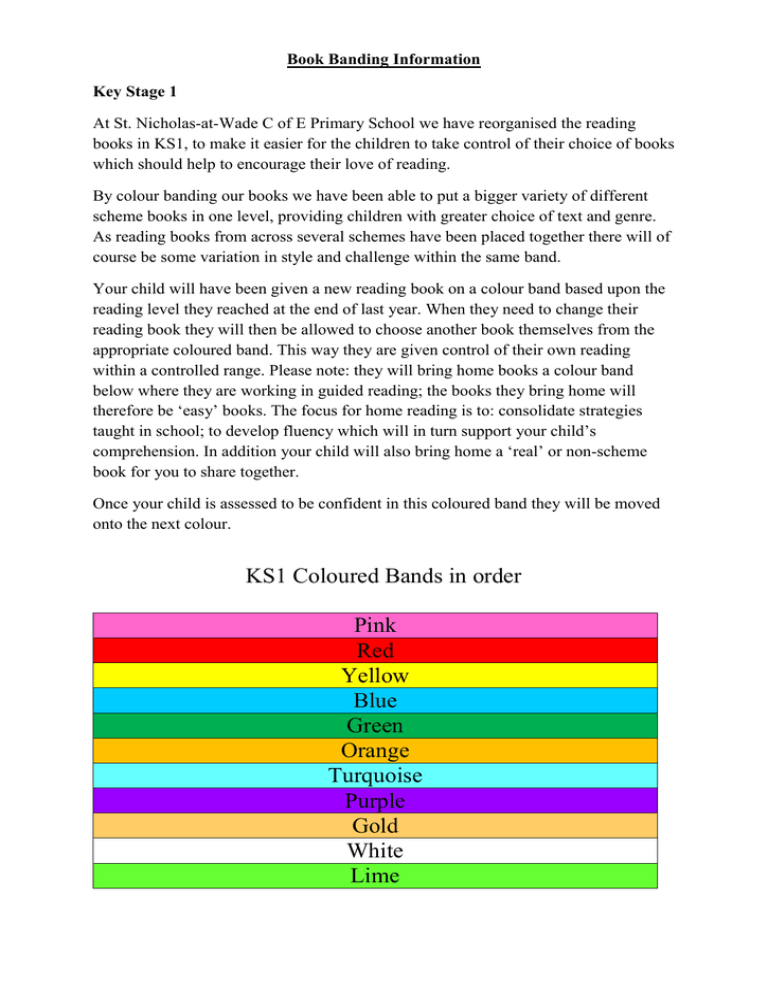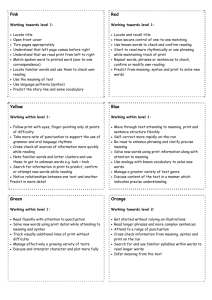KS1 Coloured Bands in order Pink Red Yellow Blue Green Orange
advertisement

Book Banding Information Key Stage 1 At St. Nicholas-at-Wade C of E Primary School we have reorganised the reading books in KS1, to make it easier for the children to take control of their choice of books which should help to encourage their love of reading. By colour banding our books we have been able to put a bigger variety of different scheme books in one level, providing children with greater choice of text and genre. As reading books from across several schemes have been placed together there will of course be some variation in style and challenge within the same band. Your child will have been given a new reading book on a colour band based upon the reading level they reached at the end of last year. When they need to change their reading book they will then be allowed to choose another book themselves from the appropriate coloured band. This way they are given control of their own reading within a controlled range. Please note: they will bring home books a colour band below where they are working in guided reading; the books they bring home will therefore be ‘easy’ books. The focus for home reading is to: consolidate strategies taught in school; to develop fluency which will in turn support your child’s comprehension. In addition your child will also bring home a ‘real’ or non-scheme book for you to share together. Once your child is assessed to be confident in this coloured band they will be moved onto the next colour. KS1 Coloured Bands in order Pink Red Yellow Blue Green Orange Turquoise Purple Gold White Lime Below are the reading strategies and levels associated with each band. Pink Locate title, Open front cover, Turn pages appropriately Understand that left page comes before right Understand that we read print from left to right Match spoken word to printed word Locate familiar word and use to check own reading Use the meaning of the text Use language patterns (print syntax) Predict the story line and some vocabulary Red Locate and recall title Have secure control of one-to-one matching Use known words to check and confirm reading Start to read more rhythmically or use phrasing Repeat words, phrases or sentences to check, confirm or modify own reading Predict from meaning, syntax and print to solve new words Yellow Follow print with eyes only, finger pointing only at points of difficulty Take more note of punctuation to support the use of grammar and oral language rhyme Cross check all sources of information more quickly while reading Note familiar words and letter clusters and use these to get unknown words e.g. Look-took Search for information in print to predict, confirm or attempt new words while reading Notice relationships between one text and another Predict in more detail Blue Moving through text attending to meaning, print and sentence flexibly Self correct more rapidly on the run Re-read to enhance phrasing and clarify precise meaning Solve new words using print information along with attention to meaning Use analogy with known vocabulary to solve new words Manage a greater variety of text genre Discuss content of the text in a manner indicating precise understanding. Green Read fluently with attention to punctuation Solve new words using print detail while attending to meaning and syntax Manage effectively a growing variety of texts Discuss and interpret character and plot more fully Orange Get started without relying on instructions Read longer phrases and more complex sentences Attend to a range of punctuation Cross-check information from meaning, syntax and print on the run Search for and use familiar syllables within words to read longer words Infer meaning from text Turquoise Extract meaning from the text while reading with less dependence on illustration Approach different genres with increasing flexibility Use punctuation and text layout to read with a greater range of expression Sustain reading through longer sentence structures and paragraphs Tackle a higher ratio of more complex words Purple Look through a variety of texts with growing independence to predict content, layout and story development Read silently or quietly at a more rapid pace, taking note of punctuation and using it to keep track of longer sentences Adapt to fiction, non – fiction or poetic language with growing flexibility Take more conscious account of literacy effects used by writers Gold Look through a variety of texts with growing independence to predict content, layout and story development Read silently or quietly at a more rapid pace, taking note of punctuation and using it to keep track of longer sentences Solve most unfamiliar words on the run Adapt to fiction, non-fiction or poetic language with growing flexibility Take more conscious account of literacy effects used by writers White Read silently most of the time Sustain interest in longer text, returning to it easily after break Use text more fully as a reference and as a model Search for and find information in texts Notice the spelling of unfamiliar words and relate to known words Show increased awareness of vocabulary and precise meaning Express reasoned opinions about what is read Offer and discuss interpretations of text Lime Recognise text type and predict layout and general content Take notes and devise ways to remember meaning and spelling of words Rerun to make different interpretations of dialogue, more complex sentences, unfamiliar language etc Investigate and identify the styles and voice of a range of different text types including plays, poetry, narrative, procedural and explanatory texts. Key Stage 2 Children in key stage 2, who have demonstrated their ability to use all the reading strategies, will move onto accelerated reader books which are also banded. Within these books children select from a wide range of books within their bands. At the end of each book the child takes a quiz which indicates their understanding of the text.


